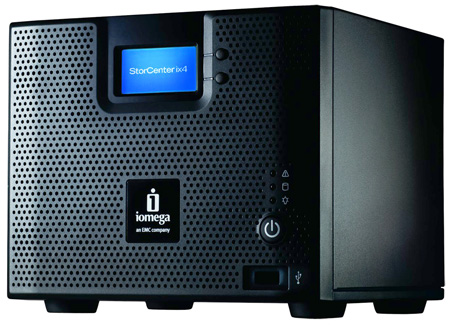While the included EMC Retrospect backup software won’t run in a server environment, I could set an iSCSI initiator to aim at the device as a storage target from anything that works with iSCSI, including Windows Server. While setting up the ix4-200d is very straightforward, setting up the iSCSI initiator depends on what operating system you’re running and can range from fairly easy to insanity-inducing. After configuration, iSCSI LUNs (logical unit numbers) are dedicated space on the StorCenter and show up in the unit’s management utility and on its front panel display.
There is a limited-function control panel on the front of the ix4-200d that let me cycle through the information that the device otherwise displays in sequence on its own, such as IP addresses and storage used. There are also two rear USB 2.0 ports and one in front, for printers or external storage. The device will support replication to another StorCenter device, to a USB device or to another network target. You can set up remote access through a web interface, and the device will support NFS (Network File System) and iSCSI in virtual environments.
Limitations on speed, power
However, it’s important to keep in mind that this is not a high-end storage device for the data centre and will not replace a higher-performance unit for some functions. This is no surprise, given how inexpensive it is. For example, while the configuration I tested for this review is a four-disk RAID 5 device, and while it does have two Gigabit Ethernet ports for either redundant or fast throughput (they can be configured as a bound pair or as individual ports), there are some areas of redundancy that are missing.
The key points of concern are power and cooling, neither of which is particularly robust. The device uses a single external power supply, and it’s cooled by a single fan. These areas of potential failure are somewhat mitigated by the fact that the device monitors the power supply, fan speed and internal temperature, and can send out alarms if any of those fail to stay within set limits. It even supports emailed alerts, so if something does begin to fail, you’ll know about it in advance.
It’s also important to know that while the ix4-200d has a lot of storage space — I tested the 4TB unit — it’s running RAID with four large SATA (Serial ATA) drives. For normal office use, this is fine. Backups work in a reasonable amount of time, and most network storage tasks effectively take place instantly. However, because of its design, this is not the best choice for some types of storage. In one test, I copied 10GB of compressed image files to the device all at once. Despite the pair of 2 Gig connections, the process took nearly 30 minutes. Network bandwidth turned out not to be the problem: There’s an upper limit to how quickly RAID-connected SATA drives can store data, and it’s a limit that you can’t get around without changing the design, and raising the price in the process.
When I compared the device’s performance with that of a Hewlett-Packard DL-385 server with six Ultra SCSI 320 drives in a RAID 5 array, the HP server was about 50 percent faster. The lesson here is that the ix4-200d isn’t the best choice for something that needs to move a huge volume of small files, so if you have a lot of transactional storage, this may not be the best selection for you. But for small and branch offices, the StorCenter ix4-200d definitely has its uses.




